A Framework for Multifunctional Green Infrastructure Planning Based on Ecosystem Service Synergy/Trade-Off Analysis: Application in the Qinling–Daba Mountain Area
Abstract
1. Introduction
2. Framework Proposal
2.1. Conceptual Framework
- How do the ESs provided by natural or semi-natural elements support the functional performance of the GI system?
- How does the functional performance of the GI system impact the delivery of ESs, particularly in terms of fostering multiple ES synergies or trade-offs?
2.2. Technical Procedure
3. Case Study in Qinling–Daba Mountain Area, China
3.1. Study Area and Materials
3.2. Framework Implementation
3.2.1. Planning Function Determination
3.2.2. Interrelation Analysis Between GI Function Performance and ES Delivery
3.2.3. Ecosystem Service Assessment and Hotspots Analysis
3.2.4. GI Element Identification and Multifunctional Mapping
3.2.5. Green Infrastructure Connectivity Analysis and Green Infrastructure Network Mapping
3.2.6. Strategic Areas/Points Identification
4. Discussion
4.1. Contributions
4.2. Challenges and Limitations
5. Conclusions
Author Contributions
Funding
Data Availability Statement
Conflicts of Interest
Appendix A. Methods for Ecosystem Service Valuation: Unit-Based ES Valuation Method
Appendix A.1. The Equivalent Coefficient Table (ECT) and the Standard Equivalent Factor (SEF) for ES Valuation
| Ecosystem Services | Food and Raw Material Supply | Water–Soil-Related Services | Habitat Services | Cultural Services | |||||
|---|---|---|---|---|---|---|---|---|---|
| Ecosystems | |||||||||
| Category | Subcategory | Food Supply | Raw Material Supply | Water Retention | Hydrological Regulation | Erosion Prevention | Soil Fertility Maintenance | Habitat Services | Cultural and Recreational Services |
| farmland | dry land | 0.85 | 0.40 | 0.02 | 0.27 | 1.03 | 0.12 | 0.13 | 0.06 |
| paddy field | 1.36 | 0.09 | −2.63 | 2.72 | 0.01 | 0.19 | 0.21 | 0.09 | |
| forest | coniferous forest | 0.22 | 0.52 | 0.27 | 3.34 | 2.06 | 0.16 | 1.88 | 0.82 |
| broad-leaved forest | 0.29 | 0.66 | 0.34 | 4.74 | 2.65 | 0.20 | 2.41 | 1.06 | |
| Bush | 0.19 | 0.43 | 0.22 | 3.35 | 1.72 | 0.13 | 1.57 | 0.69 | |
| grassland | prairie | 0.10 | 0.14 | 0.08 | 0.98 | 0.62 | 0.05 | 0.56 | 0.25 |
| shrubs | 0.38 | 0.56 | 0.31 | 3.82 | 2.40 | 0.18 | 2.18 | 0.96 | |
| wetland | wetland | 0.51 | 0.50 | 2.59 | 24.23 | 2.31 | 0.18 | 7.87 | 4.73 |
| Bare land | bare land | 0.00 | 0.00 | 0.00 | 0.03 | 0.02 | 0.00 | 0.02 | 0.01 |
| water area | waterbody | 0.80 | 0.23 | 8.29 | 102.24 | 0.93 | 0.07 | 2.55 | 1.89 |
| glacier and snow | 0.00 | 0.00 | 2.16 | 7.13 | 0.00 | 0.00 | 0.01 | 0.09 | |
| construction area | construction area | 0.00 | 0.00 | 0.00 | 0.00 | 0.00 | 0.00 | 0.00 | 0.00 |
Appendix A.2. Spatial Adjustment Factor Designation and Application
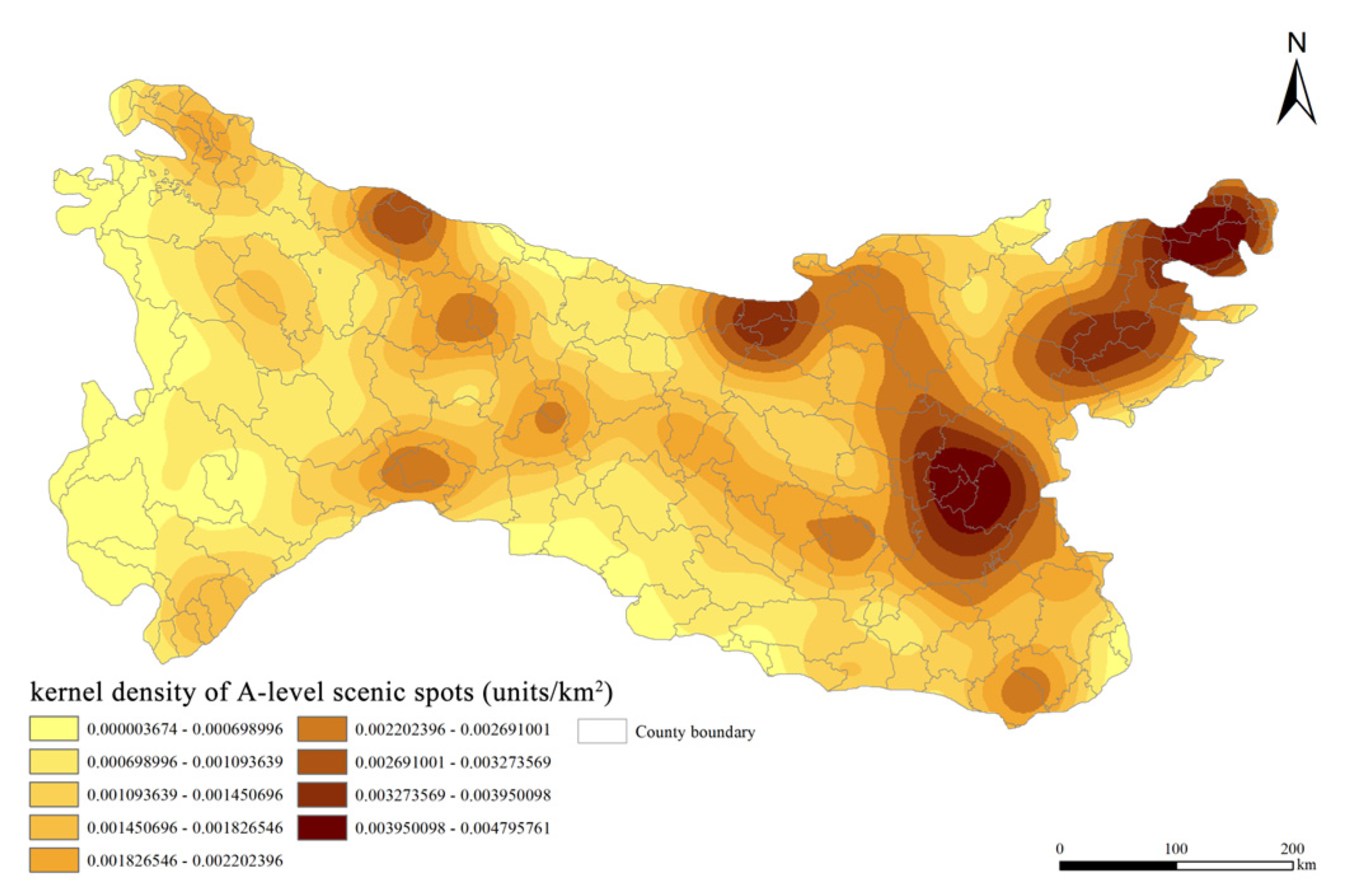
Appendix A.3. Ecosystem Service Valuation
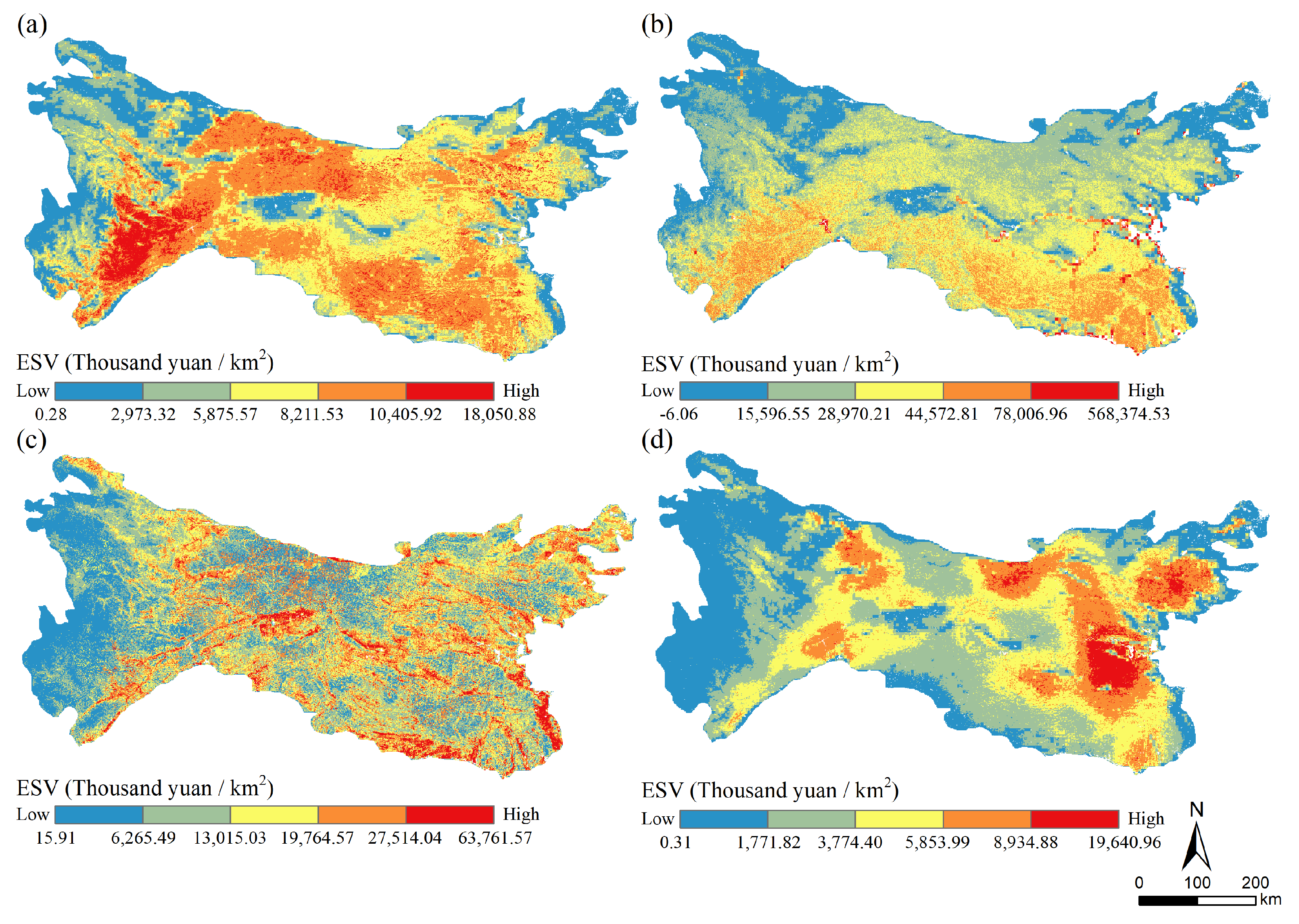
Appendix B. Method for Green Infrastructure Connectivity Analysis: Minimum Cumulative Resistance Model
| Resistance Factor | Weight | Grading Standard | Resistance Value | Resistance Factor | Weight | Grading Standard | Resistance Value |
|---|---|---|---|---|---|---|---|
| land cover | 0.4 | forest, wetland | 1 | elevation (m) | 0.15 | <700 | 10 |
| grassland, waterbodies | 20 | 700–1000 | 30 | ||||
| farmland | 50 | 1000–1500 | 50 | ||||
| bare land | 70 | 1500–2000 | 70 | ||||
| construction land | 90 | >2000 | 90 | ||||
| distance to roads (m) | 0.03 | <1000 | 90 | Slope (degree) | 0.1 | 0–8° | 10 |
| 1000–3000 | 70 | 8–15° | 30 | ||||
| 3000–5000 | 50 | 15–25° | 50 | ||||
| 5000–10,000 | 30 | 25–35° | 70 | ||||
| >10,000 | 10 | >35° | 90 | ||||
| distance to railways (m) | 0.03 | <1000 | 90 | vegetation cover (%) | 0.21 | 0–20 | 90 |
| 1000–3000 | 70 | 20–40 | 70 | ||||
| 3000–5000 | 50 | 40–60 | 50 | ||||
| 5000–10,000 | 30 | 60–80 | 30 | ||||
| >10,000 | 10 | 80–100 | 10 | ||||
| distance to waterbodies (m) | 0.05 | <1000 | 10 | distance to build-up areas (m) | 0.02 | <1000 | 90 |
| 1000–2000 | 30 | 1000–3000 | 70 | ||||
| 2000–5000 | 50 | 3000–5000 | 50 | ||||
| 5000–10,000 | 70 | 5000–10,000 | 30 | ||||
| >10,000 | 90 | >10,000 | 10 |
| 1 | Since the population density varies greatly in the study area, the log transformation is applied to control the impacts of a few extremely high values on the results. N is used for converting negative values to positive values. |
References
- Liquete, C.; Kleeschulte, S.; Dige, G.; Maes, J.; Grizzetti, B.; Olah, B.; Zulian, G. Mapping Green Infrastructure Based on Ecosystem Services and Ecological Networks: A Pan-European Case Study. Environ. Sci. Policy 2015, 54, 268–280. [Google Scholar] [CrossRef]
- Seiwert, A.; Rößler, S. Understanding the Term Green Infrastructure: Origins, Rationales, Semantic Content and Purposes as Well as Its Relevance for Application in Spatial Planning. Land Use Policy 2020, 97, 104785. [Google Scholar] [CrossRef]
- World Bank Group. Investing in Urban Resilience: Protecting and Promoting Development in a Changing World; World Bank Group: Washington, DC, USA, 2016. [Google Scholar]
- Intergovernmental Panel on Climate Change. Climate Change 2022: Mitigation of Climate Change; Intergovernmental Panel on Climate Change: Geneva, Switzerland, 2022. [Google Scholar]
- European Commission. The Multifunctionality of Green Infrastructure. In Science for Environmental Policy; European Commission: Brussels, Belgium, 2012; p. 37. [Google Scholar]
- United States Environmental Protection Agency. Available online: https://www.epa.gov/green-infrastructure (accessed on 2 June 2024).
- Bohn, K.; Chu, D. Food-Productive Green Infrastructure: Enabling Agroecological Transitions from an Urban Design Perspective. Urban Agric. Reg. Food Syst. 2021, 6, e20017. [Google Scholar] [CrossRef]
- Cook, L.M.; Good, K.D.; Moretti, M.; Kremer, P.; Wadzuk, B.; Traver, R.; Smith, V. Towards the Intentional Multifunctionality of Urban Green Infrastructure: A Paradox of Choice? npj Urban Sustain. 2024, 4, 12. [Google Scholar] [CrossRef]
- Evans, D.L.; Falagán, N.; Hardman, C.A.; Kourmpetli, S.; Liu, L.; Mead, B.R.; Davies, J.A.C. Ecosystem Service Delivery by Urban Agriculture and Green Infrastructure—A Systematic Review. Ecosyst. Serv. 2022, 54, 101405. [Google Scholar] [CrossRef]
- Lourdes, K.T.; Hamel, P.; Gibbins, C.N.; Sanusi, R.; Azhar, B.; Lechner, A.M. Planning for Green Infrastructure Using Multiple Urban Ecosystem Service Models and Multicriteria Analysis. Landsc. Urban Plan. 2022, 226, 104500. [Google Scholar] [CrossRef]
- Rigo, R.; Houet, T.; Gonthier, C. Disseminating Land Use Land Cover Change Scenarios for Improving the Role of Blue and Green Infrastructure: Evaluation and Perspectives. Environ. Sci. Policy 2024, 160, 103821. [Google Scholar] [CrossRef]
- Connop, S.; Vandergert, P.; Eisenberg, B.; Collier, M.J.; Nash, C.; Clough, J.; Newport, D. Renaturing Cities Using a Regionally-Focused Biodiversity-Led Multifunctional Benefits Approach to Urban Green Infrastructure. Environ. Sci. Policy 2016, 62, 99–111. [Google Scholar] [CrossRef]
- Hansen, R.; Pauleit, S. From Multifunctionality to Multiple Ecosystem Services? A Conceptual Framework for Multifunctionality in Green Infrastructure Planning for Urban Areas. AMBIO 2014, 43, 516–529. [Google Scholar] [CrossRef]
- Korkou, M.; Tarigan, A.K.M.; Hanslin, H.M. The Multifunctionality Concept in Urban Green Infrastructure Planning: A Systematic Literature Review. Urban For. Urban Green. 2023, 85, 127975. [Google Scholar] [CrossRef]
- McPhearson, T.; Cook, E.M.; Berbés-Blázquez, M.; Cheng, C.; Grimm, N.B.; Andersson, E.; Barbosa, O.; Chandler, D.G.; Chang, H.; Chester, M.V.; et al. A Social-Ecological-Technological Systems Framework for Urban Ecosystem Services. One Earth 2022, 5, 505–518. [Google Scholar] [CrossRef]
- Apfelbeck, B.; Snep, R.P.H.; Hauck, T.E.; Ferguson, J.; Holy, M.; Jakoby, C.; Scott MacIvor, J.; Schär, L.; Taylor, M.; Weisser, W.W. Designing Wildlife-Inclusive Cities That Support Human-Animal Co-Existence. Landsc. Urban Plan. 2020, 200, 103817. [Google Scholar] [CrossRef]
- Karlsson, A.; Guillén, L.A.; Brukas, V. Regional Forest Green Infrastructure Planning and Collaborative Governance: A Case Study from Southern Sweden. Environ. Sci. Policy 2024, 160, 103840. [Google Scholar] [CrossRef]
- Serra, V.; Defraia, S.; Ledda, A.; Calia, G.; Corona, F.; De Montis, A.; Mulas, M. Ecological Network, Ecosystem Services, and Green Infrastructure Planning: A Method for the Metropolitan City of Cagliari, Italy. Netw. Spat. Econ. 2025, 25, 95–120. [Google Scholar] [CrossRef]
- Barreira, A.P.; Andraz, J.; Ferreira, V.; Panagopoulos, T. Perceptions and Preferences of Urban Residents for Green Infrastructure to Help Cities Adapt to Climate Change Threats. Cities 2023, 141, 104478. [Google Scholar] [CrossRef]
- Murkin, K.; Shiode, N.; Shiode, S.; Kidd, D. Biodiversity and the Recreational Value of Green Infrastructure in England. Sustainability 2023, 15, 2915. [Google Scholar] [CrossRef]
- Hansen, R.; Mattes, A.; Meier, M.; Kurths, A. Reorienting Urban Green Infrastructure Planning towards Biodiversity—Perspectives and Ongoing Debates from Germany. Urban For. Urban Green. 2023, 90, 128155. [Google Scholar] [CrossRef]
- Ignatieva, M.; Mofrad, F. Understanding Urban Green Spaces Typology’s Contribution to Comprehensive Green Infrastructure Planning: A Study of Canberra, the National Capital of Australia. Land 2023, 12, 950. [Google Scholar] [CrossRef]
- Wang, Z.; Li, Z.; Wang, Y.; Zheng, X.; Deng, X. Building Green Infrastructure for Mitigating Urban Flood Risk in Beijing, China. Urban For. Urban Green. 2024, 93, 128218. [Google Scholar] [CrossRef]
- Wang, A.; Wang, J.; Zhang, R.; Cao, S. Mitigating Urban Heat and Air Pollution Considering Green and Transportation Infrastructure. Transp. Res. Part A Policy Pract. 2024, 184, 104079. [Google Scholar] [CrossRef]
- Lovell, S.T.; Taylor, J.R. Supplying Urban Ecosystem Services through Multifunctional Green Infrastructure in the United States. Landsc. Ecol. 2013, 28, 1447–1463. [Google Scholar] [CrossRef]
- Sun, Z.; Sun, J.; Guo, H.; Jiang, H.; Gao, J.; Wang, J. A Dataset of Built-up Areas of Chinese Cities in 2020[DS/OL]. Sci. Data Bank 2021, 7, 184–198. [Google Scholar] [CrossRef]
- Li, J.; He, H.; Zeng, Q.; Chen, L.; Sun, R. Dataset of Soil Conservation Capacity Preventing Water Erosion in China (1992–2019)[DS/OL]. Sci. Data Bank 2023. [Google Scholar] [CrossRef]
- National Forestry Administration, PRC. Planning for Ecosystem Protection and Construction in National Key Ecological Function Areas; China Forestry Publishing Press: Beijing, China, 2017.
- National Development and Reform Commission; National Tourism Administration. National Ecotourism Development Plan (2016–2025); National Development and Reform Commission: Beijing, China, 2016.
- Office of the Leading Group for Poverty Alleviation and Development of the State Council. Guideline for China’s Rural Poverty Alleviation and Development (2011–2020); International Poverty Reduction Center in China: Beijing, China, 2011. [Google Scholar]
- Getis, A.; Ord, J.K. The Analysis of Spatial Association by Use of Distance Statistics. In Perspectives on Spatial Data Analysis; Anselin, L., Rey, S.J., Eds.; Springer: Berlin/Heidelberg, Germany, 2010; pp. 127–145. [Google Scholar]
- Yu, K. Security Patterns and Surface Model in Landscape Ecological Planning. Landsc. Urban Plan. 1996, 36, 1–17. [Google Scholar] [CrossRef]
- Jiang, H.; Peng, J.; Xu, D.; Tang, H. Constructing Ecological Security Patterns with Differentiated Management Intensity Based on Multifunctional Landscape Identification and Multi-Criteria Decision-Making. Glob. Ecol. Conserv. 2024, 50, e02862. [Google Scholar] [CrossRef]
- Ding, M.; Liu, W.; Xiao, L.; Zhong, F.; Lu, N.; Zhang, J.; Zhang, Z.; Xu, X.; Wang, K. Construction and Optimization Strategy of Ecological Security Pattern in a Rapidly Urbanizing Region: A Case Study in Central-South China. Ecol. Indic. 2022, 136, 108604. [Google Scholar] [CrossRef]
- Peng, J.; Yang, Y.; Liu, Y.; Hu, Y.; Du, Y.; Meersmans, J.; Qiu, S. Linking Ecosystem Services and Circuit Theory to Identify Ecological Security Patterns. Sci. Total Environ. 2018, 644, 781–790. [Google Scholar] [CrossRef]
- Song, T.; Li, D.; Zhang, L.; Wang, G.; Gao, Y.; Yang, C.; Feng, C.; Ma, H. Importance Evaluation of Ecosystem Services and Construction of Ecological Security Pattern in Qinba Mountain Area. Strateg. Study Chin. Acad. Eng. 2020, 22, 64–72. [Google Scholar] [CrossRef]
- Li, X.; Ma, B.; Lu, C.; Yang, H.; Sun, M. Spatial Pattern and Development of Protected Areas in the North-South Transitional Zone of China. Chin. Geogr. Sci. 2021, 31, 149–166. [Google Scholar] [CrossRef]
- Zhang, Y.; Yin, H.; Zhu, L.; Miao, C. Landscape Fragmentation in Qinling–Daba Mountains Nature Reserves and Its Influencing Factors. Land 2021, 10, 1124. [Google Scholar] [CrossRef]
- Xie, G.; Zhang, C.; Zhen, L.; Zhang, L. Dynamic Changes in the Value of China’s Ecosystem Services. Ecosyst. Serv. 2017, 26, 146–154. [Google Scholar] [CrossRef]
- Xie, G.; Zhen, L.; Lu, C.; Xiao, Y.; Chen, C. Expert Knowledge Based Valuation Method of Ecosystem Services in China. J. Nat. Resour. 2008, 23, 911–919. [Google Scholar]
- Xie, G.; Lu, C.; Leng, Y.; Zheng, D.; Li, S. Ecological Assets Valuation of the Tibetan Plateau. J. Nat. Resour. 2003, 18, 189–196. [Google Scholar]
- Costanza, R.; d’Arge, R.; de Groot, R.; Farber, S.; Grasso, M.; Hannon, B.; Limburg, K.; Naeem, S.; O’Neill, R.V.; Paruelo, J.; et al. The Value of the World’s Ecosystem Services and Natural Capital. Nature 1997, 387, 253–260. [Google Scholar] [CrossRef]
- TEEB. The Economics of Ecosystems and Biodiversity: Ecological and Economic Foundations; Earthscan: London, UK; Washington, DC, USA, 2010. [Google Scholar]
- Jiang, H.; Peng, J.; Dong, J.; Zhang, Z.; Xu, Z.; Meersmans, J. Linking Ecological Background and Demand to Identify Ecological Security Patterns across the Guangdong-Hong Kong-Macao Greater Bay Area in China. Landsc. Ecol. 2021, 36, 2135–2150. [Google Scholar] [CrossRef]
- Zhang, Z.; Niu, J.; Cheng, Q.; Wang, Z. Construction of Eco-tourism Corridor and Eco-tourism Area in Xinyang Section of Huaihe River Basin. Xinyang Norm. Univ. (Nat. Sci. Ed.) 2023, 36, 517–522. [Google Scholar]
- Zhai, H.; Zhang, Z.; Zhao, X.; Xie, Q.; Cheng, Q.; Hu, Y. Optimization of Green Infrastructure in Xinyang City Based on Network Structure Analysis. J. Xinyang Norm. Univ. (Nat. Sci. Ed.) 2021, 34, 260–266. [Google Scholar]
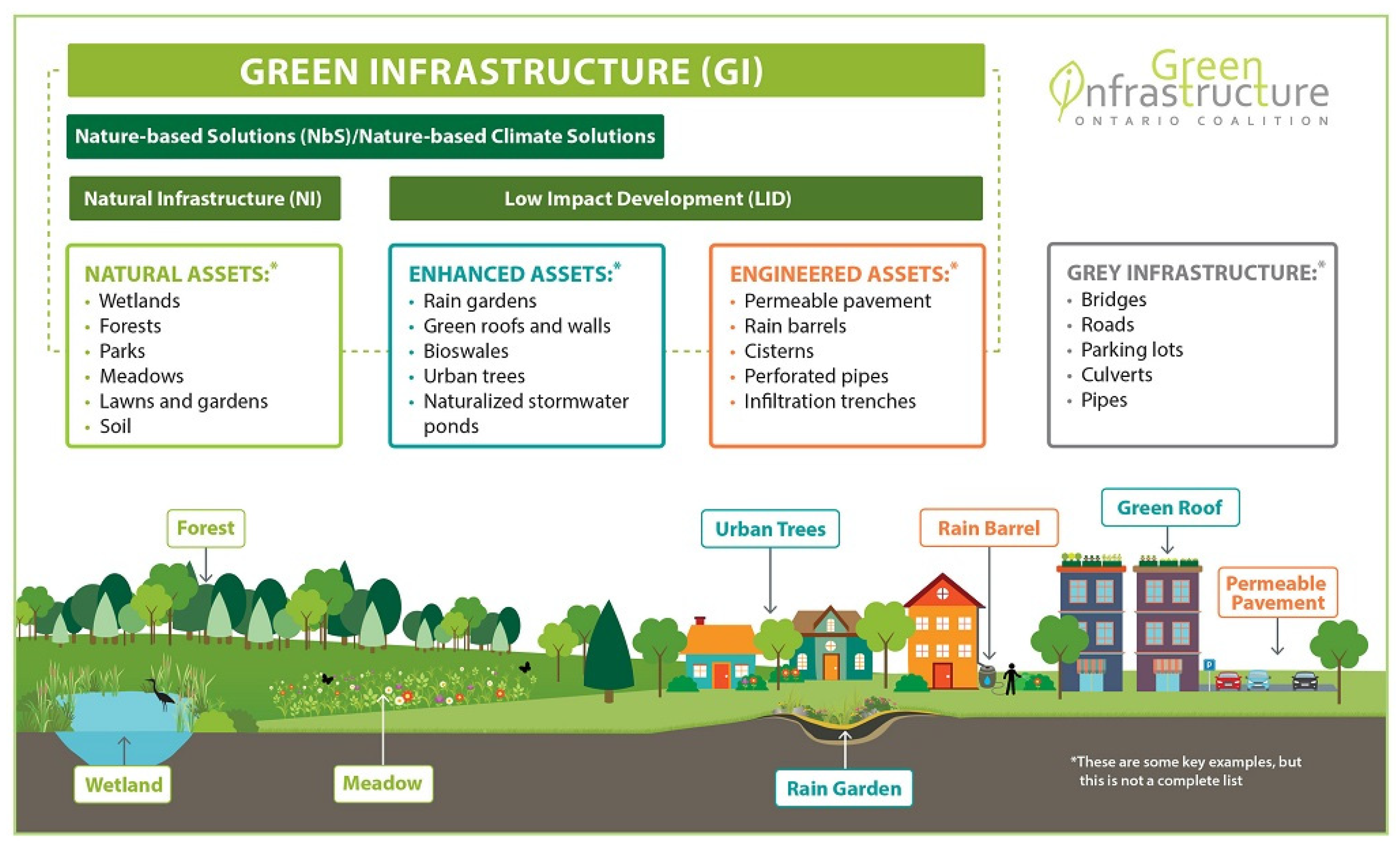

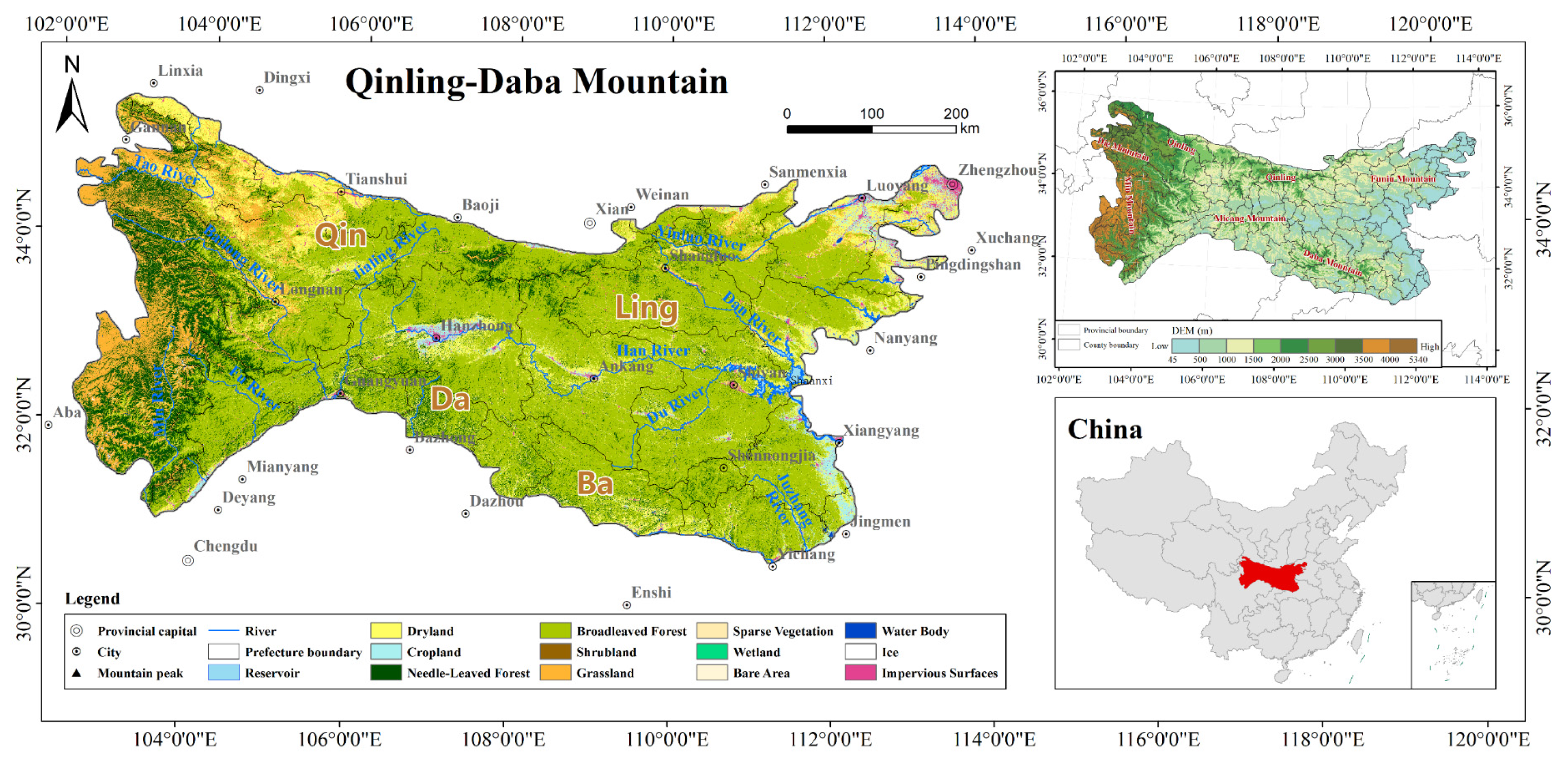
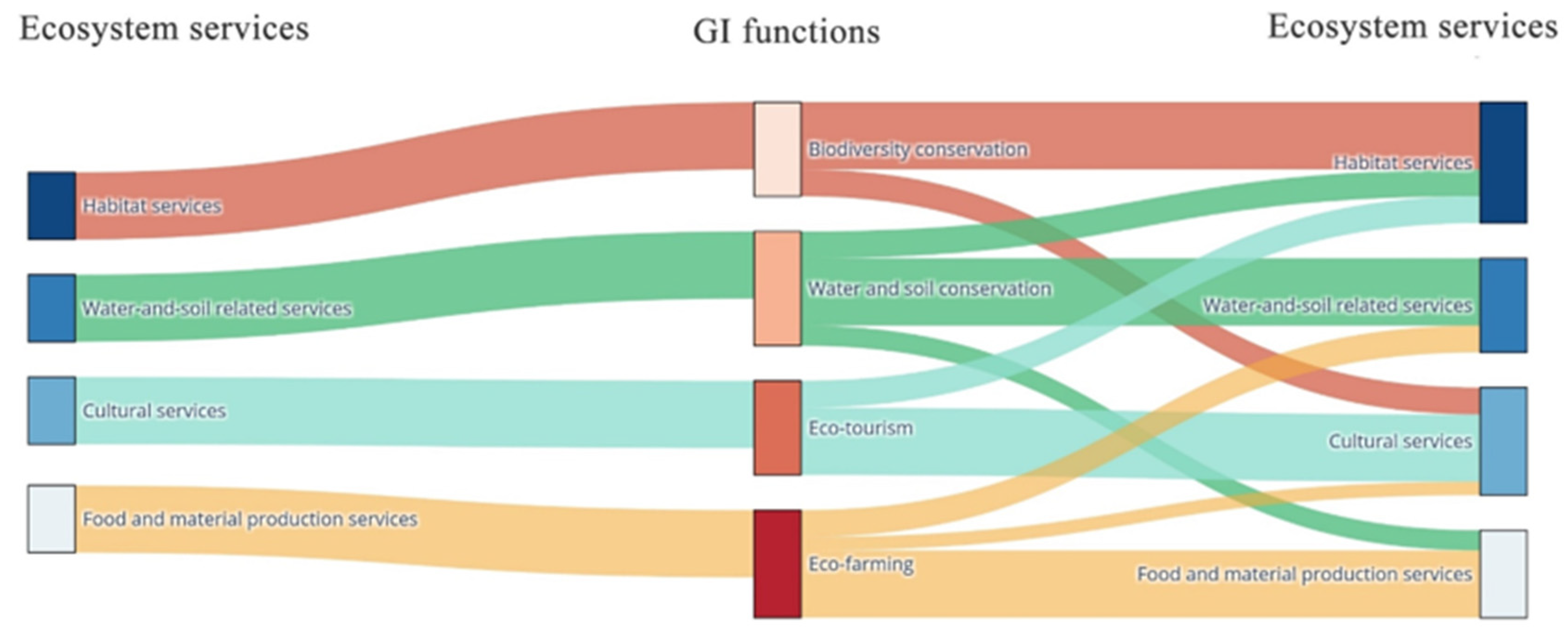
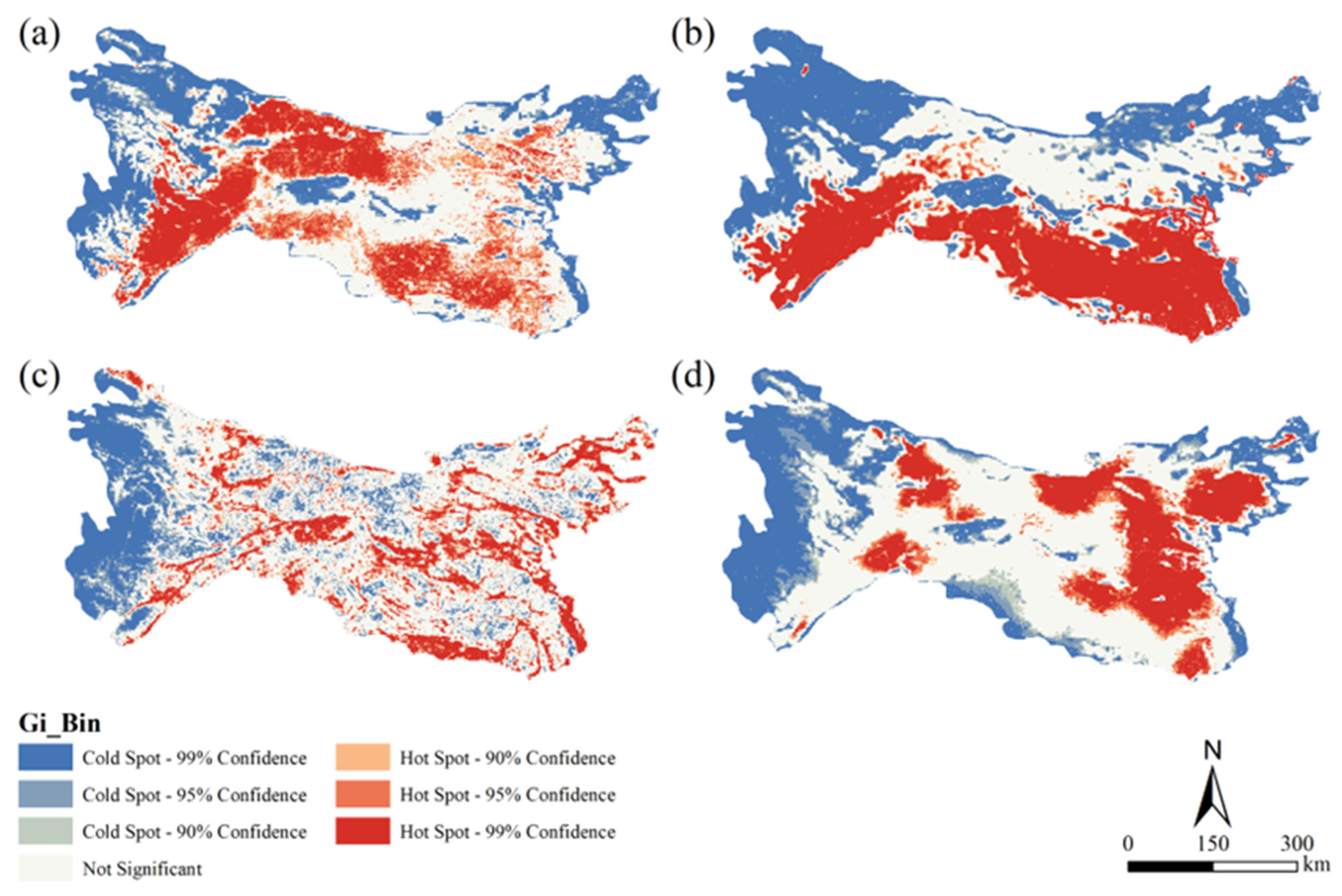
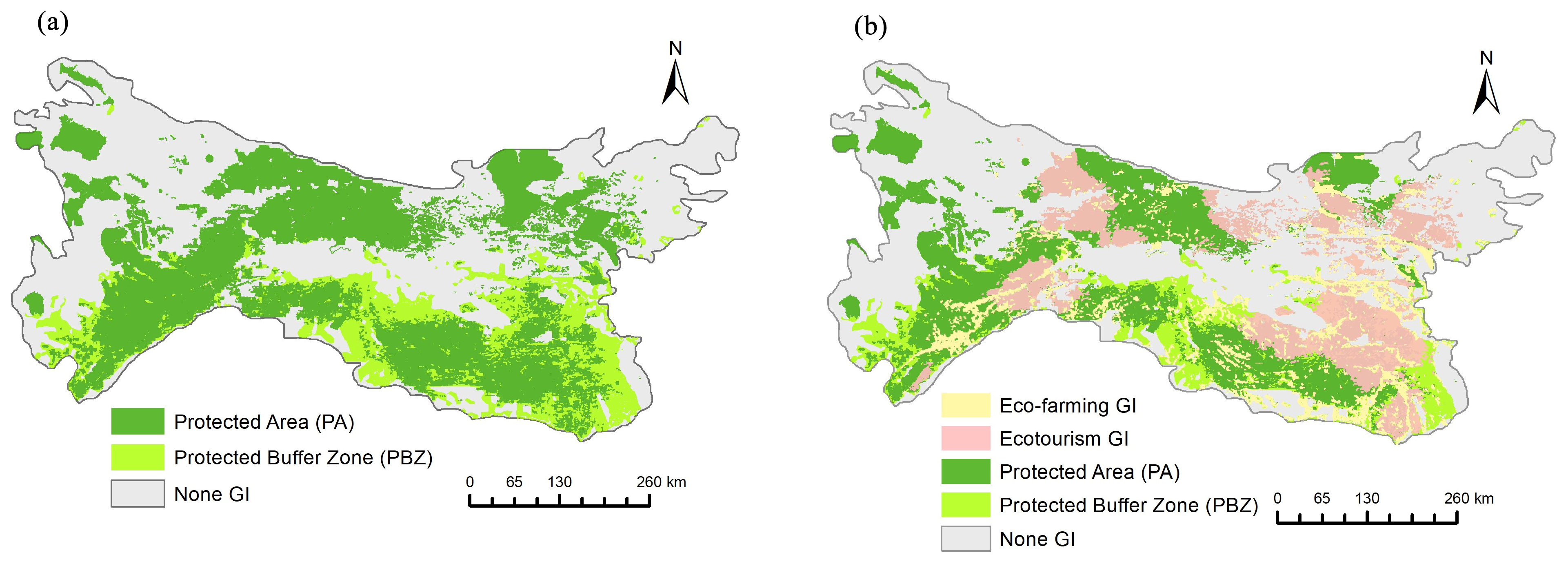
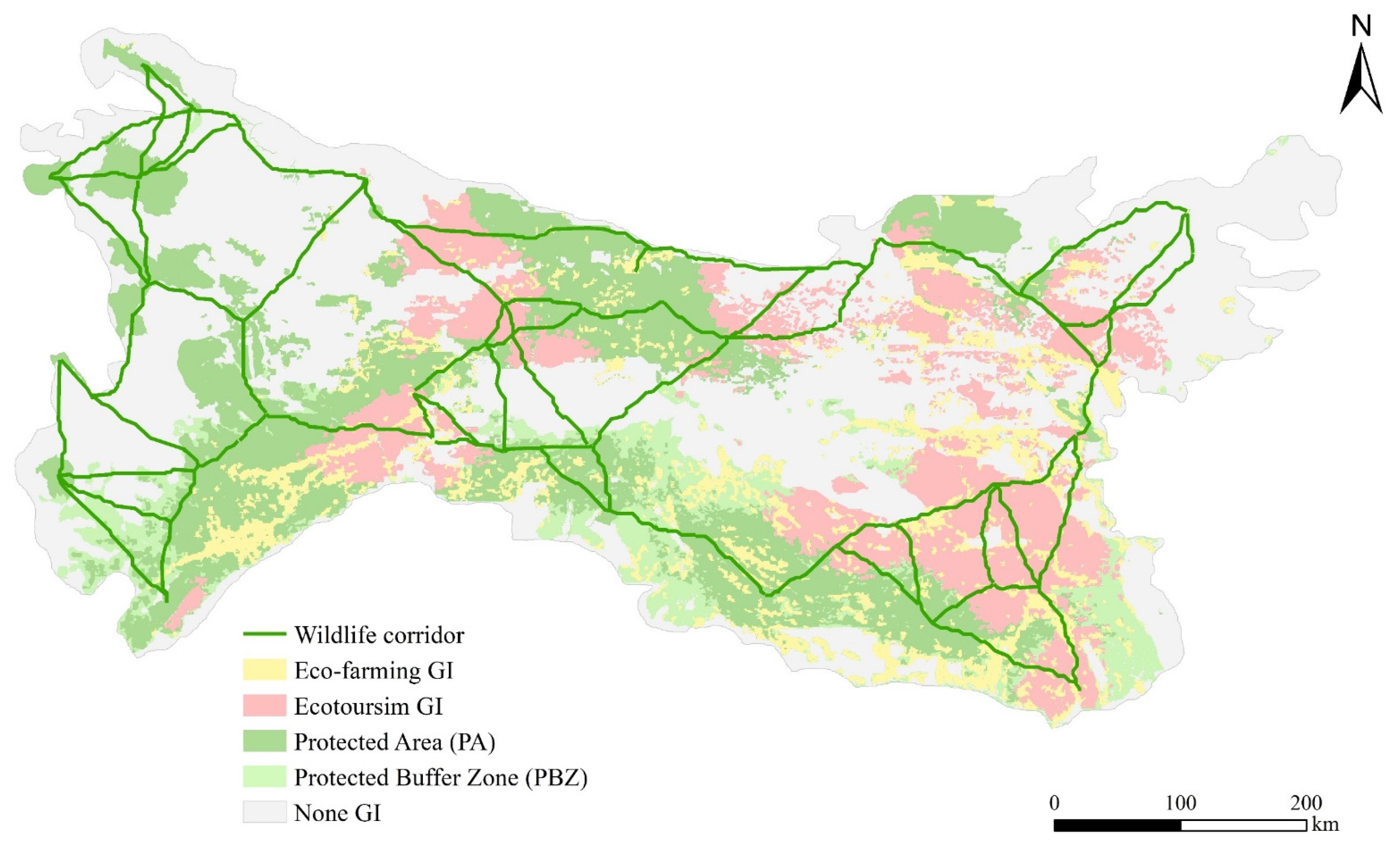
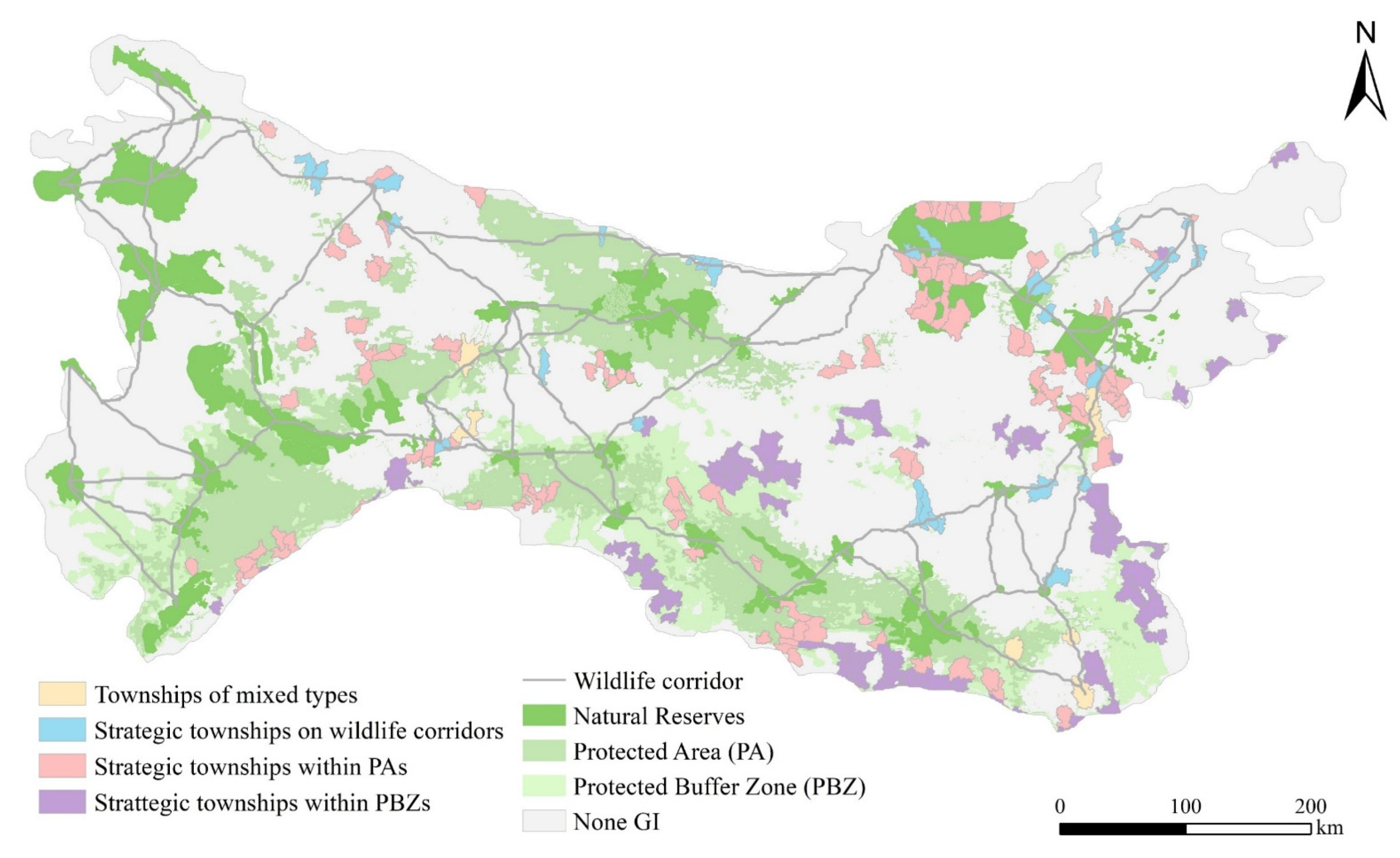

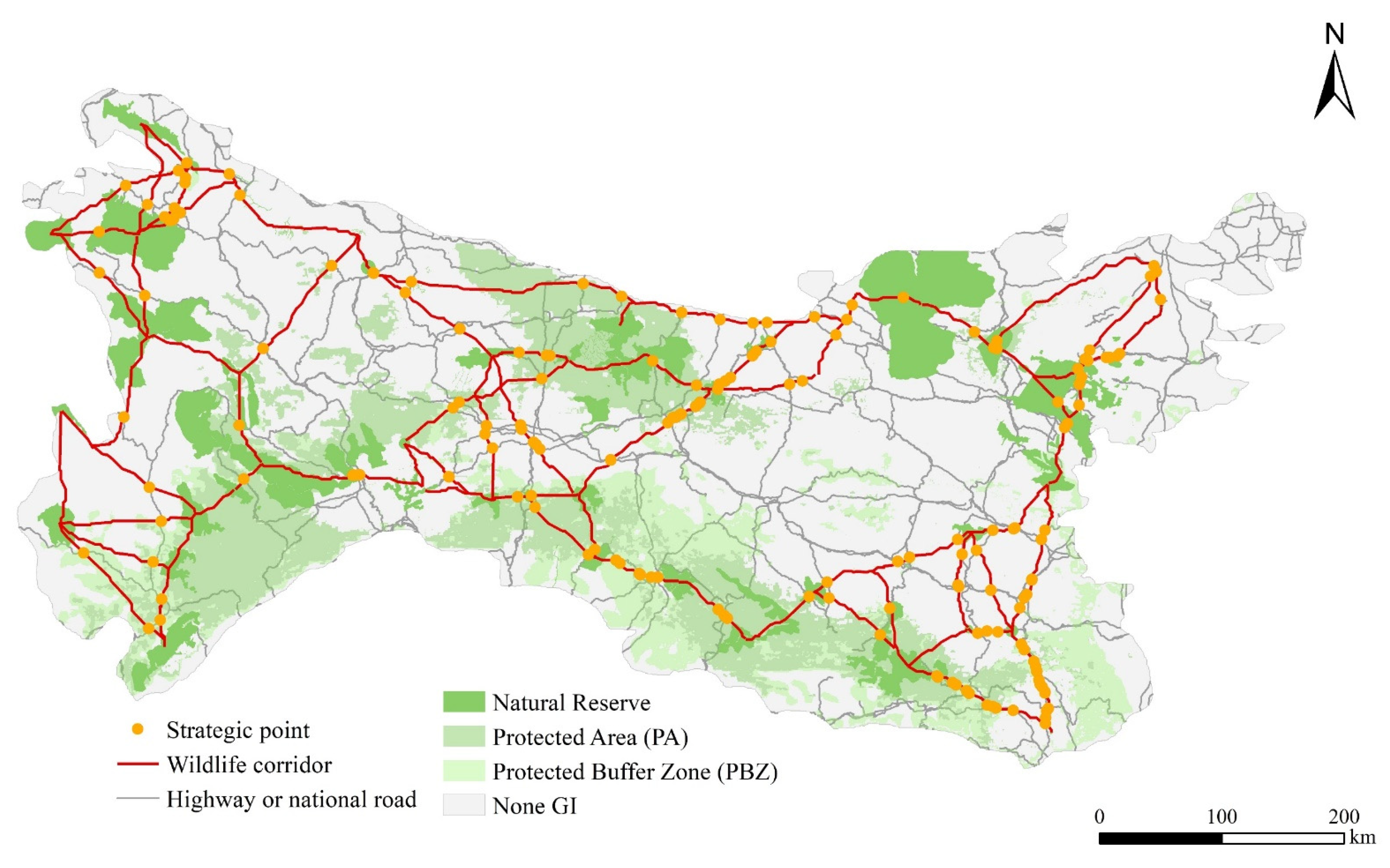
| Data | Resolution/ Year | Source | Processing |
|---|---|---|---|
| Digital Elevation Model (DEM) | 30 m/2020 | NASA https://www.nasa.gov (accessed on 19 May 2024) | Processed with ArcGIS 10.8 to obtain elevation and slope. |
| Land use and land cover | 30 m/2020 | CAS Earth Data Sharing and Service Portal https://data.casearth.cn (accessed on 20 May 2024) | Reclassified into 12 ecosystems. |
| Normalized Difference Vegetation Index (NDVI) | 30 m/2020 | Resources and Environmental Science Data Center https://www.resdc.cn (accessed on 19 May 2024) | |
| Net Primary Production (NPP) | 500 m/2020 | United States Geological Survey (USGS) https://www.usgs.gov (accessed on 19 May 2024) | |
| Precipitation | 1000 m/2020 | National Earth System Science Data Centre http://www.geodata.cn (accessed on 22 May 2024) | |
| Soil retention data | 300 m/2020 | [26] https://www.scidb.cn/en (accessed on 22 May 2024) | |
| Built-up areas of Chinese cities | 10 m/2020 | [27] https://www.scidb.cn/en (accessed on 25 May 2024) | |
| Rivers and roads | / | Open Street Map, National Geomatics of China https://www.openstreetmap.org https://www.webmap.cn (accessed on 25 May 2024) | |
| Natural reserves (NRs) | / | Geographic remote sensing ecological network platform http://www.gisrs.cn/index.html (accessed on 1 June 2024) | |
| Population | 1000 m/2019 | OakRidge National Laboratory https://landscan.ornl.gov (accessed on 2 June 2024) | |
| A-level scenic spots | / | Official website of Culture and Tourism Bureau | Converted to points with geographic coordinates in ArcGIS |
| Criteria | Planning Function |
|---|---|
| Established natural reserves * | Protected areas (PAs) |
| Hot spots of habitat services (HES) | Protected areas |
| Intersections of HES and water-and-soil service (WSES) hotspots | Protected areas |
| WSES hotspots bot not HES hotspots | Protected buffer zone (PBZs) |
| Cultural service (CES) hotspots in PAs or PBZs | Ecotourism |
| Food and material production service (FMPES) hotspots in PAs or PBZs | Eco-farming |
| Green Infrastructure Type | Multifunctionality |
|---|---|
| Protected Area | Biodiversity conservation and water and soil conservation |
| Protected Buffer Zone | Water and soil conservation |
| Eco-farming GI | Eco-farming development, biodiversity conservation, and water and soil conservation |
| Ecotourism GI | Ecotourism development, biodiversity conservation, and water and soil conservation |
Disclaimer/Publisher’s Note: The statements, opinions and data contained in all publications are solely those of the individual author(s) and contributor(s) and not of MDPI and/or the editor(s). MDPI and/or the editor(s) disclaim responsibility for any injury to people or property resulting from any ideas, methods, instructions or products referred to in the content. |
© 2025 by the authors. Licensee MDPI, Basel, Switzerland. This article is an open access article distributed under the terms and conditions of the Creative Commons Attribution (CC BY) license (https://creativecommons.org/licenses/by/4.0/).
Share and Cite
Song, M.; Li, S.; Paudel, B.; Pan, F. A Framework for Multifunctional Green Infrastructure Planning Based on Ecosystem Service Synergy/Trade-Off Analysis: Application in the Qinling–Daba Mountain Area. Land 2025, 14, 1287. https://doi.org/10.3390/land14061287
Song M, Li S, Paudel B, Pan F. A Framework for Multifunctional Green Infrastructure Planning Based on Ecosystem Service Synergy/Trade-Off Analysis: Application in the Qinling–Daba Mountain Area. Land. 2025; 14(6):1287. https://doi.org/10.3390/land14061287
Chicago/Turabian StyleSong, Mingjie, Shicheng Li, Basanta Paudel, and Fangjie Pan. 2025. "A Framework for Multifunctional Green Infrastructure Planning Based on Ecosystem Service Synergy/Trade-Off Analysis: Application in the Qinling–Daba Mountain Area" Land 14, no. 6: 1287. https://doi.org/10.3390/land14061287
APA StyleSong, M., Li, S., Paudel, B., & Pan, F. (2025). A Framework for Multifunctional Green Infrastructure Planning Based on Ecosystem Service Synergy/Trade-Off Analysis: Application in the Qinling–Daba Mountain Area. Land, 14(6), 1287. https://doi.org/10.3390/land14061287









